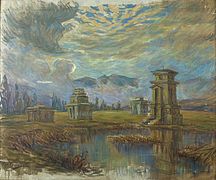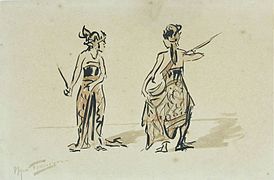art.wikisort.org - Artist
Richard Paul Max Fleischer (4 July 1861, Lipine in Oberschlesien, Kingdom of Prussia – 3 April 1930, Menton, France) was a German painter and bryologist. As a botanist, he is remembered for his work with Javan mosses.

Biography
He took art classes in Breslau, qualifying as an art teacher in 1881. He furthered his studies in Munich and Paris, where his interest in natural sciences grew. He subsequently moved to Zurich in 1892 in order to study geology. In the latter part of the 1890s, he was invited by botanist Melchior Treub to Java as an illustrator. On Java, along with his artistic duties, he collected regional botanical specimens and conducted investigations of the island's mosses. During his time spent in the Dutch East Indies, he also learned the technique of creating batik prints from vegetable dyes.[1][2]
After several years on Java, he traveled to New Guinea, the Bismarck Archipelago, Australia, New Zealand and South America, prior to returning to Germany in 1903. From 1908 to 1913, he revisited Maritime Southeast Asia, where he collected mostly bryophytes but also orchids and fungi on Java.[1][2]
In 1914 he began work at the botanical museum in Berlin and three years later, he was appointed a professor of botany at the University of Berlin. In 1925 he traveled to the Canary Islands in order to paint and to study the regions' mosses. During the following year, he relocated to The Hague, and in 1927 he returned to the Canaries with his second wife, P.G. Haigton. After his death in 1930, his private collections and library were purchased by an antiquarian in Leipzig.[1]
Gallery
- Painting of a female student
- Painting of Borobudur
- Ruins of Candi Sewu
- Painting of Candi Bima in Dieng Plateau
- Candi Arjuna in Dieng Plateau
- Painting of Balinese Temple
- Painting of Bogor Botanical Garden, where Max Fleischer work with Dr. Melchior Treub.
- Painting of 3 Javanese men in a pond
- Painting of Javanese dancers
- A Javanese river landscape
Publications
- "Die Musci der Flora von Buitenzorg : zugleich Laubmoosflora von Java / bearbeitet von Max Fleischer ; Enthaltend alle aus Java bekannt gewordenden Sphagnales und Bryales, nebst kritischen Bemerkungen vieler Archipelarten, sowie, indischer und australischer Arten"; Series: Flore de Buitenzorg ; pt. 5. Leiden : E.J. Brill, (1900-1922).[3] In the fourth volume of this work, he delineated a new natural system of classifying mosses that was subsequently adopted by Viktor Ferdinand Brotherus in his second edition of Musci in Adolf Engler's Die Natürlichen Pflanzenfamilien.[1]
See also
- List of German painters
References
- JSTOR Global Plants (biography)
- Flora Malesiana ser. 1, 1: Cyclopaedia of collectors
- Biodiversity Heritage Library Die Musci der Flora von Buitenzorg
- IPNI. M.Fleisch.
На других языках
[de] Max Fleischer (Botaniker)
Max Fleischer (* 4. Juli 1861 in Piaśniki, Oberschlesien; † 3. April 1930 in Menton, Frankreich) war ein deutscher Maler und Botaniker. Sein botanisches Kürzel lautet .mw-parser-output .Person{font-variant:small-caps}M.Fleisch.- [en] Max Fleischer (painter)
[ru] Фляйшер, Макс (художник)
Ри́хард Па́уль Макс Фля́йшер (нем. Richard Paul Max Fleischer; 1861—1930) — немецкий художник и учёный, ботаник-бриолог.Другой контент может иметь иную лицензию. Перед использованием материалов сайта WikiSort.org внимательно изучите правила лицензирования конкретных элементов наполнения сайта.
WikiSort.org - проект по пересортировке и дополнению контента Википедии









